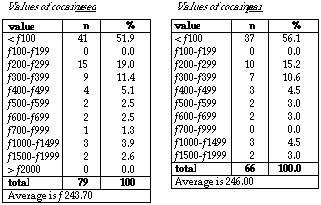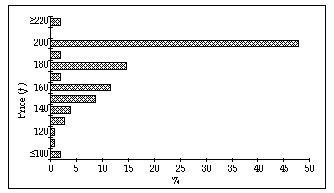Cohen, Peter (1989),
Cocaine use in Amsterdam in non-deviant subcultures. In: Peter Cohen (1990),
Drugs as a social construct. Dissertation. Amsterdam, Universiteit
van Amsterdam. pp. 114-116.
© Copyright 1990 Peter Cohen.
All rights reserved.
7. Buying cocaine
Peter Cohen
Table of contents
7.1 Introduction
We wanted to have some data on the act of buying cocaine, to check price variations and, above all, to discover where our respondents found their cocaine. For cannabis Amsterdam offers a quite distinct market of socially tolerated public distribution places, the so called 'coffeeshops'. One of the motives behind toleration of such shops has been to separate the cannabis market from all other drug markets. We wanted to find out if coffeeshops played any role at all in the distribution of cocaine.
We asked all respondents if they bought any cocaine during the four weeks preceding the interview. Apart from this we also wanted to know the total value of cocaine used in this same period, whether it was bought, received as a gift, or stolen.
Not all of our respondents bought cocaine during the four weeks preceding the interview. Only 79 knew how much money they spent on cocaine. For 90 respondents we know definitively that they used cocaine during the last four weeks, but 11 of these did not know the money value of their use. Thirteen persons used cocaine without paying for it.
Of course the average amount of paid for cocaine is higher than the average value of cocaine used, because often cocaine is given away to friends.
7.2 Price of cocaine
The average price of cocaine in the last four weeks preceding the interview was known by many more respondents than the 66 that actually bought some.
We asked the price per gram of cocaine that users had paid or would have had to pay had they bought some. The average price of 1 gram is NLG 180.
A very small proportion of our respondents would have had to pay, or actually paid less than NLG 100 per gram, and only as many paid (or would have had to pay) over NLG 220 per gram. Although we see an enormous price range, a large majority reports a cocaine price of NLG 180 [plus or minus NLG 20].
Table 7.2.a Values of cocaine used and paid during last four weeks preceding interview, and average value, in Dutch guilders (NLG 1.00 = ca $ 0.50) of those who were not abstinent.

Figure 7.2.a Current price of 1 gram of cocaine, in percentage of subsample that knew price (N=102)

7.3 Sources and location of purchase
We wanted to know where respondents normally bought cocaine: from one dealer, from several dealers or from friends. Friends are very clearly the main source of cocaine, because 45.4% of the 152 respondents who answered this question reported buying cocaine from them. Another 30.9% had a single steady dealer and only 17.8% had different dealers as their main source. The rest (5.6%) bought cocaine elsewhere or, quite probably, used cocaine without buying it. This dominance of friends or a single dealer in the purchase of cocaine is reflected by the very low percentage of the respondents who checked the quality when buying, i.e. 18%.We asked respondents to indicate the location of cocaine deals, because we wanted to know what role bars, coffeeshops[1] and disco's had in the distribution of cocaine. It appeared that 8.7% bought cocaine mainly in a bar and 12.7% mainly in a discotheque. For 78.7%, the place of business was the dealer's house, the user's own house or elsewhere. Coffeeshops were not mentioned at all.
